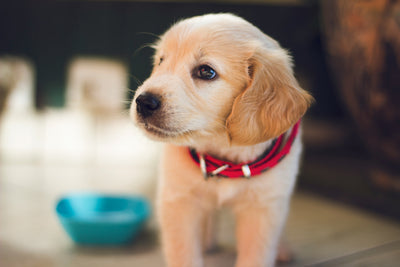Raw food diets for dogs have become increasingly popular in recent years, but are these diets really as healthy as some claim? After all, a wolf gets 100% of its nutrition from raw meat, so it's no surprise that dogs can easily eat raw meat too.
But the jury is still out. The veterinary community is divided on raw feeding, with some veterinarians supporting the practice and others strongly opposing it. If you're thinking of switching your dog to a raw diet, you can learn more about it in today's article. We`ll weigh the pros and cons of raw versus whole grain foods to provide you with a better choice.

What exactly is the meaning of Raw Diet?
Raw diet literally means feeding your dog completely raw foods such as fruits, vegetables, and meat. There are two main ways to feed a dog raw food. The first is Biologically Appropriate Raw Food (the unfortunate acronym BARF), developed by veterinarian Ian Billinghurst. It consists of 60 to 80 percent meaty bones (such as poultry necks, wings, and backs), and 20 to 40 percent fruits and vegetables, meat, eggs, dairy products, and a large amount of nutritional supplements.The second "prey model" diet closely mimics a wild dog's natural diet (think whole rabbits and pheasants). This raw food diet for dogs recommends 80% muscle, 10% bone, and 10% organ meat.
Raw food is human-grade meat and organs that are fed to dogs either whole or ground up. Many pet owners prepare their own raw food, but there are also many fresh, freeze-dried, ready-to-eat raw dog foods on the market.
Some pet owners feed their dogs only raw meat, but veterinarians advise against this because meat alone is not enough to meet a dog's complex nutritional needs. To meet your dog's nutritional needs, you should add fruits, vegetables, and supplements that are safe for dogs. Ingredients such as fish, grains, root vegetables and legumes also provide nutritional value.

Types of raw diet

Raw Food (BARF) Diet
When most people think of a raw food diet, they usually think of a biological raw food diet (sometimes called a "bones and raw food diet"). BAFA feeds your dog a variety of raw meats as well as dog-friendly fruits and vegetables. While the acronym may not sound appealing, many dogs enjoy this diet and there are very noticeable positive results, such as dogs getting shinier coats and clearer skins.
Prey model diet
The prey model diet focuses on feeding dogs a diet similar to that of wolves. The main difference between this diet and a raw food diet is that the prey model does not include fruits, vegetables, grains or dairy products. The model suggests feeding meat from other animals that the dog's ancestors may have eaten, such as rabbit, quail and duck. Some pet owners choose a prey model diet and also feed their animals complete items such as feathers and fur.
Prey models have strict proportions for the amount and type of meat a dog should eat. According to the Prey Model Diet, your dog's diet should include:
- 80% muscle
- 10% bones
- 5% liver
- 5% other organs
What are the raw food diet health benefits?

Know exactly what your pet is eating
When it comes to raw food, you don't have to guess. The benefits of feeding your dog beef cuts include: You don’t have to worry about other ingredients or allergens hiding under the generic product name description.
No preservatives or by-products
Low-quality kibble often contains fillers, by-products, and artificial preservatives that are not ideal for a healthy diet. With a raw meat diet, you don’t have to worry about your dog eating preservatives, fillers, or meat by-products.
Rich in protein and fatty acids
Raw food is rich in protein and fatty acids, which help build muscle mass and keep your pet's coat shiny.
Low carb and grain free
If your dog is gaining weight, feeding him a raw diet can help control his weight. Raw meat contains no carbohydrates, but contains enough calories and protein to keep your pet feeling full. It's also easy to adjust your dog's diet based on your veterinarian's needs and recommendations, and control exactly what he eats to lose or gain weight Unlike most commercial kibble, raw meat contains no grains, making it helpful for pets with food allergies or sensitive stomachs.
Minimal processing
Most commercial pet food manufacturers use high-temperature cooking methods that destroy essential micronutrients. Raw meat is minimally processed, so it retains most of its nutrients.
Shiny fur
A raw food diet can help keep your dog's coat shiny and healthy. Most raw foods are high in fat, which promotes healthy skin and coat. Therefore, you may notice that your dog's coat quality improves when he eats a raw diet that is high in fatty meat.
What are the risks?

Health risks to pets and humans
Many mainstream veterinarians agree that raw food diets have significant risks, which are well documented in several studies published in veterinary journals. Some household diets have been found to contain high levels of disease-causing bacteria, including E. coli and salmonella. A study by the FDA's Center for Veterinary Medicine found that 7 percent of homemade raw dog diets were contaminated with salmonella and 16 percent contained listeria. These bacteria can cause minor or serious health problems, ranging from mild stomach sensitivity to death in rare severe cases. Due to the possibility of contamination, this diet is not suitable for dogs with compromised immune systems, such as those undergoing chemotherapy or with organ failure. Furthermore, if humans are immunocompromised, both the elderly and the young are at reasonable risk from contamination.
Potential for nutritional deficiencies and imbalances
When switching your dog to a raw diet, it's important to make sure the diet is complete and balanced so your dog gets all the nutrients it needs. If the diet is not complete and balanced, your dog may experience nutritional deficiencies. Many pet owners choose a pet nutritionist to practice safe diets or add commercial supplements to their raw diet to ensure their dog gets all the nutrients, vitamins, and minerals it needs.
Some veterinarians worry that dogs fed a raw diet may be deficient in calcium and phosphorus and have too much vitamin A. Therefore, many raw food parents add supplements to their dog's diet. For healthy dogs, adding small amounts of vitamin A is rarely a problem, but puppies with liver or kidney problems may not be able to tolerate high levels of vitamin A.
Risk of obstruction and suffocation
Finally, intact bones can damage your dog's teeth and possibly cause gastric obstruction. These serious diseases can be avoided by grinding the bones in a meat grinder. However, some puppy parents prefer to feed their dogs whole, uncooked bones because they help remove plaque.
Financial and time investment costs
The final consideration when feeding your dog a raw diet is the financial and time commitment. Homemade raw food made from high-quality ingredients can be an expensive feeding method, especially for large dogs that require large amounts of food to meet their overall caloric needs. Pet owners can feed raw food at home, but this can be very difficult and inconvenient when traveling or on vacation

Raw feeding vs. mix feeding
Not everyone wants to feed their dog a completely raw diet. Some dog owners choose to mix raw meat with kibble or other ingredients. This is a personal decision and you should consult your veterinarian before making one. In some cases, feeding your dog raw products only will not provide a balanced diet, and a mixed diet (feeding raw food and freeze-dried food together) may be a better option.






